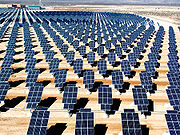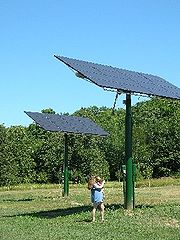
Grid-connected photovoltaic power system
Encyclopedia
Grid-connected photovoltaic power systems are power systems energised by photovoltaic panels which are connected to the utility grid. Grid-connected photovoltaic power systems comprise of Photovoltaic panels, MPPT, solar inverters, power conditioning units and grid connection equipments. Unlike Stand-alone photovoltaic power system
s these systems do not have batteries. When conditions are right, the grid-connected PV system supplies the excess power, beyond consumption by the connected load, to the utility grid.
 Residential grid-connected photovoltaic power systems which have a capacity less than 10 kilowatts can meet the load of most consumers. It can feed excess power to the grid, which in this case acts as a battery for the system. The feedback is done through a meter to monitor power transferred. A typical case is when a consumer moves out of the house on vacation, the power produced by the panels will be much in excess of the demand. In this case, the excess power can yield revenue by selling it to the grid. The consumer only needs to pay the cost of electricity generated deducted from the cost of electricity consumed.
Residential grid-connected photovoltaic power systems which have a capacity less than 10 kilowatts can meet the load of most consumers. It can feed excess power to the grid, which in this case acts as a battery for the system. The feedback is done through a meter to monitor power transferred. A typical case is when a consumer moves out of the house on vacation, the power produced by the panels will be much in excess of the demand. In this case, the excess power can yield revenue by selling it to the grid. The consumer only needs to pay the cost of electricity generated deducted from the cost of electricity consumed.
Connection of the photovoltaic power system can be done only through an interconnection agreement between the consumer and the utility company. The agreement details the various safety standards to be followed during the connection.
to step up the voltage from the solar inverter to be connected to the grid. In some systems, a dc-dc converter is utilized to step up the voltage from the inverter, so that a step-up transformer is not required.
refers to the condition in which a distributed generator
continues to power a location even though power from the electric utility
is no longer present. Islanding can be dangerous to utility workers, who may not realize that a circuit is still powered, even though there's no power from the electrical grid
. For that reason, distributed generators must detect islanding and immediately stop producing power; this is referred to as anti-islanding.
In the case of a utility blackout
in a grid-connected PV system, the solar panels will continue to deliver power as long as the sun is shining. In this case, the supply line becomes an "island" with power surrounded by a "sea" of unpowered lines. For this reason, solar inverters that are designed to supply power to the grid are generally required to have automatic anti-islanding circuitry in them.
In intentional islanding, the generator disconnects from the grid, and forces the distributed generator to power the local circuit. This is often used as a power backup system for buildings that normally sell their power to the grid.
 There are two types of anti-islanding control techniques:
There are two types of anti-islanding control techniques:
Stand-alone photovoltaic power system
Stand-alone photovoltaic power systems are power systems energised by photovoltaic panels which are independent of the utility grid. Stand-alone photovoltaic power systems are designed and sized to supply certain DC and/or AC electrical loads...
s these systems do not have batteries. When conditions are right, the grid-connected PV system supplies the excess power, beyond consumption by the connected load, to the utility grid.
Working

Connection of the photovoltaic power system can be done only through an interconnection agreement between the consumer and the utility company. The agreement details the various safety standards to be followed during the connection.
Features
In most cases, the grid-connected photovoltaic system will require a transformerTransformer
A transformer is a device that transfers electrical energy from one circuit to another through inductively coupled conductors—the transformer's coils. A varying current in the first or primary winding creates a varying magnetic flux in the transformer's core and thus a varying magnetic field...
to step up the voltage from the solar inverter to be connected to the grid. In some systems, a dc-dc converter is utilized to step up the voltage from the inverter, so that a step-up transformer is not required.
Anti-islanding
IslandingIslanding
Islanding refers to the condition in which a distributed generation generator continues to power a location even though electrical grid power from the electric utility is no longer present. Islanding can be dangerous to utility workers, who may not realize that a circuit is still powered, and it...
refers to the condition in which a distributed generator
Distributed generation
Distributed generation, also called on-site generation, dispersed generation, embedded generation, decentralized generation, decentralized energy or distributed energy, generates electricity from many small energy sources....
continues to power a location even though power from the electric utility
Electric utility
An electric utility is a company that engages in the generation, transmission, and distribution of electricity for sale generally in a regulated market. The electrical utility industry is a major provider of energy in most countries. It is indispensable to factories, commercial establishments,...
is no longer present. Islanding can be dangerous to utility workers, who may not realize that a circuit is still powered, even though there's no power from the electrical grid
Electric power transmission
Electric-power transmission is the bulk transfer of electrical energy, from generating power plants to Electrical substations located near demand centers...
. For that reason, distributed generators must detect islanding and immediately stop producing power; this is referred to as anti-islanding.
In the case of a utility blackout
Power outage
A power outage is a short- or long-term loss of the electric power to an area.There are many causes of power failures in an electricity network...
in a grid-connected PV system, the solar panels will continue to deliver power as long as the sun is shining. In this case, the supply line becomes an "island" with power surrounded by a "sea" of unpowered lines. For this reason, solar inverters that are designed to supply power to the grid are generally required to have automatic anti-islanding circuitry in them.
In intentional islanding, the generator disconnects from the grid, and forces the distributed generator to power the local circuit. This is often used as a power backup system for buildings that normally sell their power to the grid.
Types of anti-islanding protection

Passive
The voltage and/or the frequency change during the grid failure is measured and a positive feedback loop is employed to push the voltage and /or the frequency further away from its nominal value. Frequency or voltage may not change if the load matches very well with the inverter output or the load has a very high quality factor (reactive to real power ratio). So there exists some Non Detection Zone (NDZ).Active
This method employs injecting some error in frequency or voltage. When grid fails, the error accumulates and pushes the voltage and/or frequency beyond the acceptable range.Advantages
- A grid-connected photovoltaic power system will reduce the power bill as it is possible to sell surplus electricity produced to the local electricity supplier.
- Grid-connected PV systems are comparatively easier to install as they do not require a battery system.
- Grid interconnection of photovoltaic (PV) power generation systems has the advantage of effective utilization of generated power because there are no storage losses involved.
See also
- Stand-alone photovoltaic power systemStand-alone photovoltaic power systemStand-alone photovoltaic power systems are power systems energised by photovoltaic panels which are independent of the utility grid. Stand-alone photovoltaic power systems are designed and sized to supply certain DC and/or AC electrical loads...
- List of rooftop photovoltaic installations
- Photovoltaic power plant
- Solar Energy Generating SystemsSolar Energy Generating SystemsSolar Energy Generating Systems is the largest solar energy generating facility in the world. It consists of nine solar power plants in California's Mojave Desert, where insolation is among the best available in the United States...
- Building-integrated photovoltaics
- Solar inverter
- Solar cableSolar cableSolar cable is the interconnection cable used in photovoltaic power generation. A solar cable interconnects solar panels and other electrical components in the photovoltaic system. Solar cables are designed to be UV resistant and weather resistant...
- Maximum power point trackerMaximum power point trackerMaximum power point tracking is a technique that grid tie inverters, solar battery chargers and similar devices use to get the maximum possible power from the PV array. Solar cells have a complex relationship between solar irradiation, temperature and total resistance that produces a non-linear...
- Solar trackerSolar trackerA solar tracker is a generic term used to describe devices that orient various payloads toward the sun. Payloads can be photovoltaic panels, reflectors, lenses or other optical devices....
- Solar shinglesSolar shinglesSolar shingles, also called photovoltaic shingles, are solar cells designed to look like conventional asphalt shingles. There are several varieties of solar shingles, including shingle-sized solid panels that take the place of a number of conventional shingles in a strip, semi-rigid designs...

